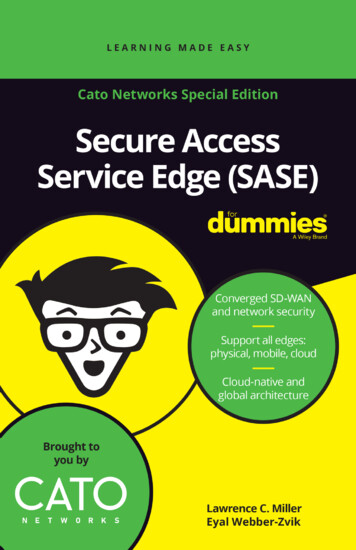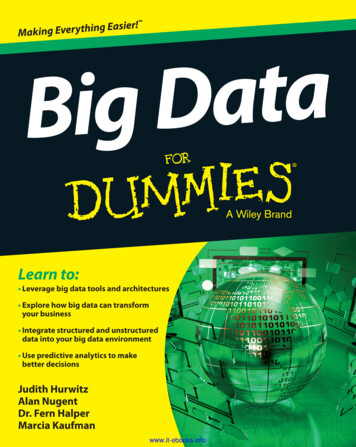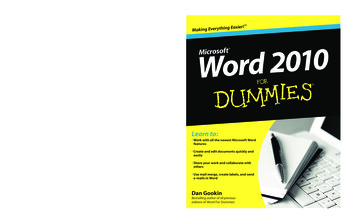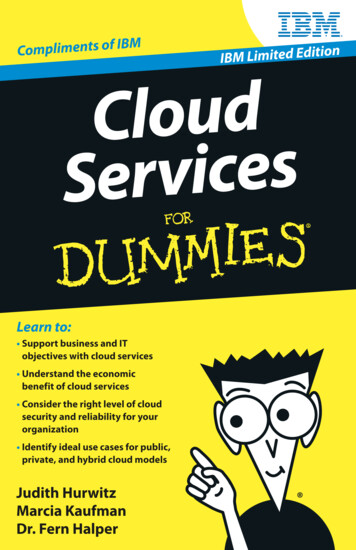
Transcription
These materials are 2020 John Wiley & Sons, Inc. Any dissemination, distribution, or unauthorized use is strictly prohibited.
Secure AccessService Edge(SASE)Cato Networks Special Editionby Lawrence C. Millerand Eyal Webber-ZvikThese materials are 2020 John Wiley & Sons, Inc. Any dissemination, distribution, or unauthorized use is strictly prohibited.
Secure Access Service Edge (SASE) For Dummies , Cato NetworksSpecial EditionPublished byJohn Wiley & Sons, Inc.111 River St.Hoboken, NJ 07030-5774www.wiley.comCopyright 2020 by John Wiley & Sons, Inc., Hoboken, New JerseyNo part of this publication may be reproduced, stored in a retrieval system or transmitted in anyform or by any means, electronic, mechanical, photocopying, recording, scanning or otherwise,except as permitted under Sections 107 or 108 of the 1976 United States Copyright Act, withoutthe prior written permission of the Publisher. Requests to the Publisher for permission should beaddressed to the Permissions Department, John Wiley & Sons, Inc., 111 River Street, Hoboken, NJ07030, (201) 748-6011, fax (201) 748-6008, or online at http://www.wiley.com/go/permissions.Trademarks: Wiley, For Dummies, the Dummies Man logo, Dummies.com, and related tradedress are trademarks or registered trademarks of John Wiley & Sons, Inc. and/or its affiliates inthe United States and other countries, and may not be used without written permission. CatoNetworks and the Cato logo are trademarks or registered trademarks of Cato Networks. All othertrademarks are the property of their respective owners. John Wiley & Sons, Inc., is not associatedwith any product or vendor mentioned in this book.LIMIT OF LIABILITY/DISCLAIMER OF WARRANTY: THE PUBLISHER AND THE AUTHOR MAKE NOREPRESENTATIONS OR WARRANTIES WITH RESPECT TO THE ACCURACY OR COMPLETENESS OF THECONTENTS OF THIS WORK AND SPECIFICALLY DISCLAIM ALL WARRANTIES, INCLUDING WITHOUTLIMITATION WARRANTIES OF FITNESS FOR A PARTICULAR PURPOSE. NO WARRANTY MAY BE CREATEDOR EXTENDED BY SALES OR PROMOTIONAL MATERIALS. THE ADVICE AND STRATEGIES CONTAINEDHEREIN MAY NOT BE SUITABLE FOR EVERY SITUATION. THIS WORK IS SOLD WITH THE UNDERSTANDINGTHAT THE PUBLISHER IS NOT ENGAGED IN RENDERING LEGAL, ACCOUNTING, OR OTHER PROFESSIONALSERVICES. IF PROFESSIONAL ASSISTANCE IS REQUIRED, THE SERVICES OF A COMPETENT PROFESSIONALPERSON SHOULD BE SOUGHT. NEITHER THE PUBLISHER NOR THE AUTHOR SHALL BE LIABLE FORDAMAGES ARISING HEREFROM. THE FACT THAT AN ORGANIZATION OR WEBSITE IS REFERRED TO INTHIS WORK AS A CITATION AND/OR A POTENTIAL SOURCE OF FURTHER INFORMATION DOES NOT MEANTHAT THE AUTHOR OR THE PUBLISHER ENDORSES THE INFORMATION THE ORGANIZATION OR WEBSITEMAY PROVIDE OR RECOMMENDATIONS IT MAY MAKE. FURTHER, READERS SHOULD BE AWARE THATINTERNET WEBSITES LISTED IN THIS WORK MAY HAVE CHANGED OR DISAPPEARED BETWEEN WHENTHIS WORK WAS WRITTEN AND WHEN IT IS READ.For general information on our other products and services, or how to create a custom For Dummiesbook for your business or organization, please contact our Business Development Department inthe U.S. at 877-409-4177, contact info@dummies.biz, or visit www.wiley.com/go/custompub.For information about licensing the For Dummies brand for products or services, contactBrandedRights&Licenses@Wiley.com.ISBN 978-1-119-72154-3 (pbk); ISBN 978-1-119-72155-0 (ebk)Manufactured in the United States of America and Great Britain10 9 8 7 6 5 4 3 2 1Publisher’s AcknowledgmentsWe’re proud of this book and of the people who worked on it. For details onhow to create a custom For Dummies book for your business or organization,contact info@dummies.biz or visit www.wiley.com/go/custompub. For detailson licensing the For Dummies brand for products or services, contact BrandedRights&Licenses@Wiley.com.Some of the people who helped bring this book to market include thefollowing:Project Editor: Martin V. MinnerExecutive Editor: Steve HayesEditorial Manager: Rev MengleBusiness DevelopmentRepresentative: Molly DaughertyProduction Editor: Umar SaleemThese materials are 2020 John Wiley & Sons, Inc. Any dissemination, distribution, or unauthorized use is strictly prohibited.
Table of ContentsINTRODUCTION. 1About This Book. 1Foolish Assumptions. 2Icons Used in This Book. 2CHAPTER 1:Modern Business Trends and Challenges. 3Looking at What Drives Businesses Today. 3Digital transformation. 3Cloud and mobility. 4Globalization. 4Risk and compliance. 4Tracing the Evolution of Network and Security Architectures. 5Understanding Current Network and Security Limitations. 6Becoming a Digital Business. 7CHAPTER 2:The Emergence of Convergence: SASE. 9Defining SASE — Not New, Just Better Together. 9Introducing Cloud-Native Networking and Security. 14CHAPTER 3:Understanding SASE Capabilities. 17Network as a Service. 17Edge SD-WAN. 17Global private backbone. 19Secure and optimized cloud access. 20Zero Trust Network Access (ZTNA). 21Security as a Service. 22Firewall as a Service (FWaaS). 23Secure web gateway (SWG). 23Next-generation antimalware (NGAM). 24IPS as a Service. 24CHAPTER 4:Looking at SASE in Action. 27Retail. 27Pharmaceuticals. 30Financial Services. 32Manufacturing. 35Table of ContentsiiiThese materials are 2020 John Wiley & Sons, Inc. Any dissemination, distribution, or unauthorized use is strictly prohibited.
CHAPTER 5:Ten Things to Consider WhenEvaluating a SASE Vendor. 39Convergence. 39Cloud Native. 40Global. 40All Edges. 41Unified Management. 42All Traffic. 42Deployment Flexibility. 43Resiliency. 43Elasticity and Scalability. 44Self-Healing. 44ivSecure Access Service Edge (SASE) For Dummies, Cato Networks Special EditionThese materials are 2020 John Wiley & Sons, Inc. Any dissemination, distribution, or unauthorized use is strictly prohibited.
IntroductionSecure Access Service Edge (SASE) is a new enterprise infrastructure technology category introduced by Gartner in2019. SASE converges the functions of networking and network security point solutions into a unified, global, cloud-nativeservice. It is an architectural transformation of enterprise networking and security that enables IT to provide a holistic,agile, and adaptable service to the digital business. What makesSASE unique is its transformational impact across multiple ITdomains.Solving emerging business challenges with point solutions leadsto technical silos that are complex and costly to own and manage.Complexity slows down IT and its response to these businessneeds. SASE changes this paradigm through a new networkingand security platform that is identity-driven, cloud-native, globally distributed, and securely connects all edges to the wide-areanetwork: datacenters, offices, cloud resources, mobile and remoteusers, and Internet of Things (IoT) devices.With SASE, enterprises can reduce the time to develop new products, deliver them to the market, and respond to changes inbusiness conditions or the competitive landscape.About This BookSecure Access Service Edge For Dummies, Cato Networks Special Edition, consists of five chapters that explore:»» Modern business trends and challenges and what it takes tobecome a digital business today (Chapter 1)»» Bringing networking and security together in a SASE solution(Chapter 2)»» The core capabilities of SASE (Chapter 3)»» Real-world industry use cases for SASE (Chapter 4)»» Key evaluation criteria to consider when selecting a SASEvendor (Chapter 5)Introduction1These materials are 2020 John Wiley & Sons, Inc. Any dissemination, distribution, or unauthorized use is strictly prohibited.
Each chapter is written to stand on its own, so if you see a topicthat piques your interest, feel free to jump ahead to that chapter.You can read this book in any order that suits you (though I don’trecommend upside down or backward).Foolish AssumptionsIt’s been said that most assumptions have outlived their uselessness, but I assume a few things nonetheless.Mainly, I assume that you know a few things about cloud, networking, and security. Perhaps you’re an IT, network, or securityarchitect, or a CIO, CISO, or IT director. As such, this book is written primarily for technical readers who are evaluating solutionsto address modern networking and security challenges in theirenterprise networks.If any of these assumptions describe you, then this is the bookfor you. If none of these assumptions describe you, keep readinganyway! It’s a great book and you’ll learn quite a bit about modernenterprise networking and security.Icons Used in This BookThroughout this book, I occasionally use special icons to callattention to important information. Here’s what to expect:This icon points out important information you should committo your nonvolatile memory, your gray matter, or your noggin —along with anniversaries and birthdays.If you seek to attain the seventh level of NERD-vana, perk up!This icon explains the jargon beneath the jargon and is the stuffnerds are made of.Tips are appreciated, never expected — and I sure hope you’llappreciate these useful nuggets of information.2Secure Access Service Edge (SASE) For Dummies, Cato Networks Special EditionThese materials are 2020 John Wiley & Sons, Inc. Any dissemination, distribution, or unauthorized use is strictly prohibited.
IN THIS CHAPTER»» Understanding key technology trendsand business drivers»» Looking at the evolution of networkingand security architectures»» Recognizing modern network andsecurity challenges»» Identifying the needs of the digitalbusinessChapter1Modern Business Trendsand ChallengesIn this chapter, you explore modern business and technologytrends, how networking and security architectures haveevolved, the limitations of these architectures in today’s digitalbusiness world, and what it takes to become a digital businesstoday.Looking at What Drives Businesses TodaySeveral important trends over the past decade have reshapedenterprise networking and security requirements. This sectionexplores several of these trends.Digital transformationBusinesses everywhere are undertaking digital transformationinitiatives to revolutionize the way they do business and reinvent their industries. Technology innovations have enabled manycore business processes to be automated and optimized, enablinggreater efficiency, quality, and overall productivity.CHAPTER 1 Modern Business Trends and Challenges3These materials are 2020 John Wiley & Sons, Inc. Any dissemination, distribution, or unauthorized use is strictly prohibited.
Cloud and mobilityCloud and mobile computing are two of the most importanttrends of the past decade. The rapid growth of software as aservice (SaaS), platform as a service (PaaS), and infrastructureas a service (IaaS) public cloud offerings has enabled businessesto rapidly scale their operations to support growth and demand,leverage agility and flexibility in service offerings to acceleratetime-to-market, and reduce capital expenditures (CapEx) bytaking advantage of consumption-based, pay-as-you-go pricing.Likewise, the proliferation of mobile devices and high-performancecellular networks, including 4G Long-Term Evolution (LTE) and5G, enables individuals to work from practically anywhere on evermore powerful mobile devices.GlobalizationGlobalization has been a business trend for many decades, but theInternet has accelerated this trend, enabling businesses of practically any size to compete in the global economy. But although theInternet has been a globalization enabler, it exposes new challengesand risks, due to the lack of secure, reliable, high-speed Internetconnectivity in many regions of the world where businesses areseeking growth and expansion.Globalization also enables organizations to diversify their workforce, selecting the best talent from practically anywhere in theworld. Cloud and mobile computing have contributed to this opportunity by increasingly enabling employees to work from anywhere.The COVID-19 global pandemic has driven many organizations torethink their policies regarding work-from-home, as they recognize not only the health and safety aspects of these arrangements,but also the productivity benefits. The next challenge for theseorganizations will be to ensure reliable and predictable secure network connectivity and data protection for their employees, regardless of where they work and the devices they use.Risk and complianceBusinesses today face greater risk, not only because of increasingly sophisticated threats and large-scale attacks, but also dueto an increasingly complex regulatory landscape. In addition tosecurity requirements such as the U.S. Sarbanes-Oxley (SOX) Act,U.S. Health Insurance Portability and Accountability Act (HIPAA),and Payment Card Industry (PCI) Data Security Standards (DSS),4Secure Access Service Edge (SASE) For Dummies, Cato Networks Special EditionThese materials are 2020 John Wiley & Sons, Inc. Any dissemination, distribution, or unauthorized use is strictly prohibited.
organizations in every industry must now also comply with stringent privacy regulations such as the European Union GeneralData Protection Regulation (GDPR), Australian Privacy Principles(APP), and California Consumer Privacy Act (CCPA).Tracing the Evolution of Networkand Security ArchitecturesWhen organizations began connecting their local area networks(LANs) across multiple locations in the 1980s, they used dedicated point-to-point (P2P) leased lines, then Frame Relay, tobuild their wide-area networks (WANs).In the 2000s, multiprotocol label switching (MPLS) connectionsenabled carriers to replace Frame Relay, providing an IP-basedsolution to converge voice, video, and data on the same network.MPLS provides dependable network connections backed byservice-level agreements (SLAs), but it is expensive and can takemonths to plan and provision.In 2013, software-defined wide-area networks (SD-WAN)emerged as a viable and cost-effective alternative to MPLS —making it the logical next evolution in WAN architecture. Byabstracting the network layer and routing traffic based upon centrally defined and managed policies, SD-WAN optimizes the routing and prioritization of application traffic.At the same time, security teams have had to adapt to increasingly diverse and sophisticated threats and attack prevention.Initially, network firewalls were deployed at the perimeter betweenthe “trusted” corporate network and the “untrusted” Internet.Organizations traditionally maintained the entire security stackin their headquarters or data center and backhauled all branchnetwork traffic through this central location. Alternatively, theymight deploy a partial security stack with reduced functionality intheir branch locations to offload some of the network congestion.However, both options required a compromise between securityand performance and neither option was optimal for serving theneeds of the organization and its branch locations.As applications increasingly started sharing the same ports andprotocols — often to promote ease of installation and use by effectively circumventing traditional network firewalls — the need forCHAPTER 1 Modern Business Trends and Challenges5These materials are 2020 John Wiley & Sons, Inc. Any dissemination, distribution, or unauthorized use is strictly prohibited.
application-aware next-generation firewalls emerged. Internetand SaaS traffic from branch locations also increased, as well asthe scale and sophistication of cyberattacks and attack vectors.This situation led to more siloed point security solutions — suchas secure web gateways (SWGs), intrusion detection systems andintrusion prevention systems (IPS), anti-malware, and others —being deployed in branch locations where specialized security andtechnical skills were generally not available.This evolution of network and security architectures has creatednew challenges for businesses that have embraced digital transformation, cloud, and mobile computing trends while strugglingto compete in a global market and address greater risk and compliance requirements.Understanding Current Networkand Security LimitationsNetworking and security teams have traditionally addressedemerging business needs with point solutions. For example,adding SD-WAN appliances to offload capacity-constrained andexpensive MPLS connections to Internet links, or adding firewallsin branch offices to secure direct Internet access. This approachhas created technological silos, built with point solutions thatare loosely integrated and separately managed. Ultimately, ITneeds to provide consistent performance and robust security, ina cost-effective way, to all business resources globally. This is anarchitectural challenge, not a functional problem, that requiresthe elimination of IT silos, as well as the use of point solution“band-aids” to address new business requirements.Specific challenges and limitations associated with current network and security architectures include:»» Location- and perimeter-based designs: Network architec-tures have traditionally been designed with logical (IP-based)topologies overlaying a physical network, datacenter, servers,and applications. Similarly, security appliances, such as firewalls,are commonly deployed at the network perimeter betweenthe “trusted” corporate network and the “untrusted” Internet.However, these location- and perimeter-based designs do notadapt easily to the dynamic nature of cloud computing and6Secure Access Service Edge (SASE) For Dummies, Cato Networks Special EditionThese materials are 2020 John Wiley & Sons, Inc. Any dissemination, distribution, or unauthorized use is strictly prohibited.
virtual resources. Applications and their associated microservices move dynamically across virtual machines and containersand between public and private clouds. The concept ofperimeter-based security is still relevant, but with networktraffic now flowing to multiple datacenters, public clouds(including SaaS, PaaS, and IaaS environments), and the Internet,there are now multiple perimeters that are more difficult toprotect than a single perimeter.»» Complexity in multiple network and security pointsolutions maintained by limited staff and requiringhighly specialized skills: Network and security engineersare highly skilled (and expensive) resources — and there isa growing worldwide shortage of qualified individuals to fillavailable positions in the workforce. Complexity in networkdesigns and lack of interoperability between multipledisparate networking point products and technologies —such as SD-WAN, MPLS, private backbones, WAN optimizers,and VPNs — as well as siloed security technologies — suchas next-generation firewalls, secure web gateways (SWGs),web application firewalls (WAFs), intrusion preventionsystems (IPSs), software-defined perimeters (SDPs), cloudaccess security brokers (CASBs), content filtering, securityinformation and event management (SIEM), and more —makes it still more challenging for network and security staffto learn different systems and technologies, and createsgreater risk of outages and security vulnerabilities due tomisconfiguration and improper or sub-optimal operationand troubleshooting.»» Legacy technologies don’t adapt to modern needs:Inefficient workarounds — such as backhauling branchoffice Internet and cloud traffic across MPLS connectionsand “tromboning” (that is, looping back) network trafficto force it through a perimeter firewall or other securitydevice — create complexity and latency in network andsecurity architectures.Becoming a Digital BusinessThe digital business is all about speed: faster product development, faster time to market, and faster responsiveness tochanging market conditions. Technology enables business agility.CHAPTER 1 Modern Business Trends and Challenges7These materials are 2020 John Wiley & Sons, Inc. Any dissemination, distribution, or unauthorized use is strictly prohibited.
Automation, agility, elasticity, and flexibility are key traits of themodern IT infrastructure, which is increasingly delivered in thecloud.But unlike cloud computing, networking and security are painfully incompatible with the cloud-centric and mobile-first business of today. The network is rigid and static. Security is heavilyfragmented across multiple domains of physical locations, cloudresources, and mobile users. Together, networking and security are slowing down the business as silos erected decades agoare stretched and patched to accommodate emerging businessrequirements.Many telcos now offer to take care of all the complexity in networking and security for enterprise IT teams with a managedservices “bundle.” However, these services are built around theirMPLS services and delivered in much the same manner as othertelco services — which aren’t known for their speed, agility,and customer experience. Being a digital business means beinga cloud-first, fast, and agile business — which is incompatiblewith legacy telco carrier WAN architectures and network services.Legacy MPLS networks no longer work for the digital businessbecause:»» MPLS is expensive, rigid, and not built for cloud access»» Direct and secure Internet access is needed everywherewhile MPLS networks centralize Internet access and backhauls traffic to centralized Internet access points»» MPLS is limited to physical locations, making cloud andmobile resources second-class citizens»» MPLS networks require separate appliances and solutions,complicating network management and life cyclemaintenanceLegacy telco carriers are the wrong partners for digital businesses because they are expensive, bureaucratic (it can takemonths to deploy new sites), slow (they rely on ticket-based service requests), and they provide limited customer visibility andcontrol.IT architecture must evolve beyond silos and point solutions tosupport the digital business today and in the future. This is themain driver for the Secure Access Service Edge (SASE).8Secure Access Service Edge (SASE) For Dummies, Cato Networks Special EditionThese materials are 2020 John Wiley & Sons, Inc. Any dissemination, distribution, or unauthorized use is strictly prohibited.
IN THIS CHAPTER»» Learning what SASE is — and isn’t»» Recognizing the benefits of cloud-nativenetworking and securityChapter2The Emergence ofConvergence: SASEIn this chapter, you discover how SASE brings core networkingand security capabilities together in a complete solution, andthe benefits of leveraging a cloud-native networking and security architecture.Defining SASE — Not New,Just Better TogetherTo address the needs of the digital business and secure the newenterprise multi-perimeter (discussed in Chapter 1), Gartner hasdefined a new architecture: Secure Access Service Edge (SASE).SASE converges the functions of network and security point solutions into a unified, global cloud service.SASE architecture is built for full visibility to all traffic from alledges — physical, cloud, and mobile — including traffic betweenthe edges (WAN), and from the edges to the Internet. SASE appliesa rich set of security and networking engines on traffic, enablingfull inspection for threat prevention and access control.CHAPTER 2 The Emergence of Convergence: SASE9These materials are 2020 John Wiley & Sons, Inc. Any dissemination, distribution, or unauthorized use is strictly prohibited.
The key components of a SASE architecture (see Figure 2-1)include:»» SASE cloud: A globally distributed cloud service that deliversthe networking and security capabilities to all edges. TheSASE cloud operates as a single entity and its internalstructure is transparent to the end-users.»» SASE points of presence (PoPs): A specific instance withinthe SASE cloud that hosts the resources needed to deliverthe SASE capabilities including servers, network connectivity,and software. SASE PoPs are symmetrical, interchangeable,multi-tenant, and mostly stateless. They are built to serveany enterprise edge connected through them as an integralpart of that particular enterprise network.»» SASE edge: Designed to connect a specific edge to the SASEcloud. SASE clients include SD-WAN appliances for branches,IPSec-enabled firewalls and routers, and device agents forWindows, Mac, iOS, Android, and Linux.»» SASE management: Configure all policies and view networkand security analytics and real-time status, in an intuitive,single-pane-of-glass, cloud-based management console.FIGURE 2-1: SASE extends networking and security to all edges includingphysical locations, clouds, users, and edge computing.SASE is a new category of cloud-native networking and securitysolutions, but the technologies and services delivered in a SASEsolution are themselves not necessarily new — they are just converged into a unified, cloud-native solution.10Secure Access Service Edge (SASE) For Dummies, Cato Networks Special EditionThese materials are 2020 John Wiley & Sons, Inc. Any dissemination, distribution, or unauthorized use is strictly prohibited.
SASE details an architectural transformation of enterprisenetworking and security that will enable IT to provide a holistic,agile, and adaptable service to the digital business. The individualtechnologies and services that comprise a SASE solution broadlyconsist of network-as-a-service and security-as-a-service offerings including:»» Network as a service SD-WAN WAN optimization Bandwidth aggregation Global private backbone»» Security as a service Firewall as a service (FWaaS) Secure web gateway (SWG) Next-generation antimalware (NGAM) Intrusion prevention system (IPS) Cloud access security broker (CASB) Software-defined perimeter (SDP), also referred to asZero Trust network access (ZTNA)Read Chapter 4 to learn about SASE network-as-a-service andsecurity-as-a-service offerings.SASE has four main characteristics. It is:»» Identity-driven: Unlike many networking and security pointsolutions that rely on IP addresses to identify a resource,SASE determines the true identity of every enterpriseresource, whether it is a person, an application, a service, ora device. Identity, as part of a broad and dynamic contextawareness, drives the risk and network service profile ofevery flow and the resulting combination of authenticationmethods, threat inspection, and data access authorization.Identity is integral through the access life cycle of a resource,from ensuring quality of service (QoS) to applying risk-drivensecurity controls and more.»» Cloud-native: SASE is a cloud-native solution delivered in an“as-a-service” consumption model. A cloud-nativeCHAPTER 2 The Emergence of Convergence: SASE11These materials are 2020 John Wiley & Sons, Inc. Any dissemination, distribution, or unauthorized use is strictly prohibited.
architecture leverages key cloud capabilities includingmultitenancy, scalability, velocity, efficiency, and ubiquity.»» All edges: SASE seamlessly supports all enterprise edgeswith full networking and security capabilities everywhere. Byadopting a cloud-first approach to networking and security,SASE decouples many common capabilities, such as networkoptimization and threat prevention, from physical edgelocations and places them in the cloud.»» Globally distributed: SASE is implemented as a glo
THE FACT THAT AN ORGANIZATION OR WEBSITE IS REFERRED TO IN . For general information on our other products and services, or how to create a custom For Dummies book for your business or organizati











